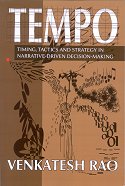Tempo: timing, tactics and strategy in narrative-driven decision-making.
Lightning Source. 2011
Life is a verb, not a noun.
— Charlotte Perkins Gilman
Rao starts from the idea of process, of a sequence of events, and goes from there, to bring in the concept of time. His time is not merely an ordering of events, but is a measure of the rate, of the tempo, of those events. Understanding the tempo of the various processes, and how these interact, and interweave, is the basis of his discussion of decision making, from individual cooking to multi-person businesses.
Understanding the dynamics of the decision-making process exposes various phenomena that can be part of the process. Rao identifies fait accompli, brinkmanship, procrastination, second-guessing, passive aggression, time-outs, defaulting, and building mindshare, among others.
We constantly need to make decisions, and those decisions need to be situated in the current context. Context switching includes gaining situational awareness (grokking where things are and what they are doing, now and in the near future) in the new context. Situational awareness crucially includes awareness of the situation’s tempo.
p115. The major claim in this book is that tempo can be used to modulate enactments that move along too quickly to manage one micro decision at a time.
p118. The primary effect of operating at a faster tempo is that you can maneuver inside the decision cycle of your opponent, disrupting his or her enactment …
This style is obviously effective in adversarial settings, but it is equally effective in cooperative settings …. The alert waiters at upscale restaurants, fulfilling your needs before you even recognize them, are a good example.
p127. To externalize a mental model is to arrange our physical environment to serve our intentions more efficiently. In cognitive psychology, this idea is called distributed cognition.
Different styles of decision making follow different patterns; Rao identifies reactive, deliberative, opportunistic, and procedural. For example, a procedural, or bureaucratic, style has the environment organised by another, so that you can follow a codified process without necessarily understanding it, yet still achieve the desired outcome.
Civilisation advances by extending the number of important operations which we can perform without thinking about them.
— Alfred North Whitehead
On the other hand, our personal, efficient organisation of our environment has meaning to us. This meaning may be legible to others, or it may not. If we wish to organise in concert with others, we need to be legible to them, but this might impact our own efficiency. Bosses who demand tidy desks are prioritising their own need for legibility, for control, over their staff’s efficient meaningful organisation.
Central planners can have the same desire for control, but this can kill the very thing they are trying to create.
p133. … central planners begin by poorly internalizing a rich, emergent collectively externalized mental model (such as the structure of an old city). They proceed inevitably to failure when they attempt to replace it with the externalization of their own impoverished mental models, constructed largely out of primitive platonic ideals, a case of design destroying dance.
p138. Fields are arrangements of the physical environment. Flows are the behaviors that result when humans interact with a field. Flows are the observable parts of others’ enactments.
p139. For a given individual, the environmental field … combines with the other group members in the field at the same time, to create a social field. When there is little momentum or meaning in the primary environmental field, the dynamics of the social field start to dominate. An environmental field that is deliberately designed to catalyze complex social behaviors generally contains one or more social objects…. Chairs and tables are among the simplest social objects.
p141. Artistic approaches to field-flow complexes exploit the natural chemistry among mental models in richer ways. The key to such approaches is a tasteful blending of preparatory design and participatory dance. Successful field-flow complexes can neither be designed nor danced into existence. They must be orchestrated. A conductor or choreographer, rather than a pure designer or dancer, is necessary.
Complex systems comprise a collection of agents interacting in and with a complex environment. For a single agent, its environment comprises not only the organised spaces, but the other agents, too. In Rao’s model, the agents are people making their context-dependent situated decisions.
p143. Groups cannot be realistically studied unless you take into account the effects of the field-flow complexes that they inhabit. This is a natural consequence of narrative rationality: you can only understand a group with reference to the specific narrative within which it is situated.
Rao demonstrates how a consideration of tempo, situation and context, and of patterns of decision making, can illuminate many more patterns than the standard procedural bureaucratic one. Moreover, these other patterns and metaphors have distinctly different flavours, especially when applied to changing an organisation.
p144. Where change in the machine metaphor is a process of stepwise re-engineering, in the other, more organic metaphors, change is a process of generative growth, ontogeny and self-organization.This book nicely complements a lot of books trying to apply complexity theory to organisations. Here Rao focuses on complex human systems, involved in descion making, aspects often missing from the more theoretical models of complex systems exploited by the other approaches.
This deserves rereading. Some of the earlier discussions, which can have a slightly hippy-Zen flavour (despite many examples being from military command and control) take on more meaning in light of the later application. Recommended.
For all my book reviews, see my main website.

No comments:
Post a Comment